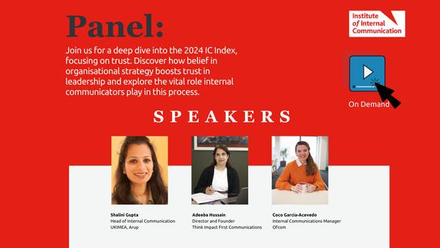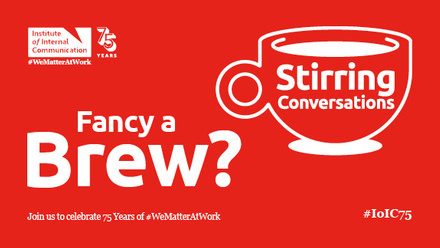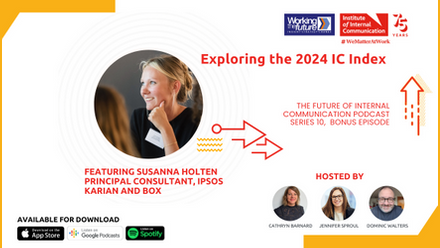Getting the measure of your strategy: using data to drive IC’s direction
Measuring the success of your internal comms content is no simple task. There is so much to analyse, it’s hard to know where to start and what “good” even looks like. With an IC strategy linking IC priorities to the corporate vision, your measurement should, in theory, be more substantial.
When it comes to analysing data, first try and define the problem you are solving.
Abhijit Shanker, founder of online education community ZEducatr and formerly chief of internal communication at UNICEF, says: “You have to be very focused on that particular question to begin with. I would advise internal communicators to have an external board of advisers – people in the private sector, non-profit organisations, academia – who you consult with every three to six months, so you know what the trends are. You can end up drowning in data.”
Measure changes in behaviour
Communication strategist Mike Klein focuses less on think, feel, do and more on do, know, feel and say.
“You can measure those four things more easily – whether you want people to do more of X, less of X or do X differently. As an example, pre-Covid, there was a hospital that wanted more employees to use hand sanitiser wipes. They distributed wipes without any message and measured natural usage, and then they ran an internal comms campaign to get people to do it. It essentially became a campaign about communication, rather than using wipes.”
Whether you are gauging sentiment through surveys, focus group discussions or online communities, find out what exactly has influenced changes in behaviour or the way people work over the previous 12 months.
Look at projects and processes and whether they are more time- or cost-efficient, or innovative, or consistent through shared best practice – and dig deep to find out why. Has communication contributed to the improvement? Has a lack of communication or access to information stalled progress? If people say they are proud to work for the organisation or are more motivated, follow up to determine if a particular channel or campaign helped? Just knowing that people are more proud or motivated is not enough.
“The company is measured on the basis of business performance,” says Mike, “so look at how IC directly or measurably, even if indirectly, affects business performance.”
While there are plenty of questions to ask, Mike highlights two killer questions: What are the top three priorities facing the organisation? What are the three things you are working on?
“What do you want people to do – and find out how often that shows up in what people say,” he says.
Don’t measure everything
Look at your outputs and consider the outcomes. Are you giving people the information they need to do their jobs better? Is it timely and relevant? Which channels do you really need?
“Don’t measure everything,” says Abhijit. “Measure what matters. The channels matter. Your questions should relate to how people are accessing channels or how useful they find them. What do people want on the intranet? In a live meeting with the CEO, if 50 per cent of people don’t have the bandwidth to watch it or they are falling asleep, it’s a pointless exercise. If you are sending out a newsletter, have a mechanism for people to say what they think of it. Have feedback buttons on your intranet home page.”
Click rates and open rates have little substance. So people are on the intranet and opening pages? What benefit do they get from the actual message? Consider how your content can help you track interest. You can’t tell if someone has read an email they have opened, but you can see if someone has played a video all the way through or turned it off after five seconds.
Look at channels as part of a larger strategy. Are you being too ambitious in striving for a 100 per cent open rate with one channel, rather than considering your channel suite working in harmony to collectively reach as many people as possible?
And look for the stories in the data. One channel might not be as popular as another in terms of the number of people who use it – but everyone who does use might love it.
What is “engagement” anyway?
Be clear about the terms you measure against. Don’t be deceived or flattered by your “engagement score”. What does engagement or disengagement really mean to you?
Mike reflects: “Is someone who has given up completely, shows up to the office but goes on YouTube for eight hours the same as someone who does their work for eight hours but doesn’t look at the intranet, or an active saboteur, trying to blow up the process? Disengagement does not discriminate.
“And engagement – is that someone with 30 years’ service with a smile every day? Or would you rather have someone for three years who sparks a bunch of good ideas before moving on. Is retention your measure for motivation?”
Kimberley-Marie Sklinar, communications manager at AutoProtect Group, has a long-term aim to produce an engagement scorecard – like a healthcheck for each department, covering everything from attrition and sickness data to project delays and how busy the phone lines are. She’ll then analyse what the data is telling her in that moment.
“Is it a good time to launch change?” she reflects. “What is the reason for people not reading an email? Is it the date we send it? You don’t want to be measuring for measurement’s sake. Consider how you are going to react to the figures – and that should inform your strategy.
“I have presented survey results to comms champions. It’s often a bunch of numbers, but they are useful for telling me it could be this or that, which puts something on the bones. I task comms champions with going out to teams and feeding back to me in team meetings. They tell me things I wouldn’t think about because I’m too close to it.”
Measurement deserves a deep dive. You can’t have a half-baked plan.
Make the time to do it, urges Kim. “If you don’t measure, you’re not being strategic. You’re flying by the seat of your pants. Don’t take numbers at face value. Be curious. Why did only 20 per cent of people respond to a message? Was it boring? Was the subject line wrong? Did everyone actually receive it? Was the IT not working?”
This deeper analysis equips you with the evidence – and confidence – you need to show your effectiveness.
“When I present my findings to leadership, I don’t tell them what they could be doing better,” continues Kim. “I say, ‘This is what people are taking about.’ I pull out key themes and statistics and tell them I can send them the full presentation. If you go to those meetings, and say, ‘The business could look like this’, it raises the stakes and your profile in the business.”
Stay in control
Christopher Flores, formerly head of corporate communications and CEO office at comms platform company BICS, believes the most important thing is to choose meaningful metrics completely within the IC team’s control.
“If you are trying to create a strong employer brand because you are recruiting, you might pick talent acquisition as your metric because that is your organisation’s goal, but unless you are involved in recruitment yourself, it’s not a metric IC can control.”
Measurement data should not just be something captured in analytic boxes in platforms. Internal communicators have to go out and get the data they need. Whatever statistics you have, enhance them by exploring the issues with conversations in the workplace – and then take appropriate action.
“My strong belief is any survey provides an indication of where you should start to investigate,” says Christopher. “If there are results you don’t understand or need clarity on, you can organise a focus group, or talk to people.”
Christopher realised a core group of people never attended all-hands meetings, and they were asked to complete a survey.
“We learned that sometimes the reason was work-related and people couldn’t physically leave their desk,” says Christopher. “There were some who just didn’t care. You can’t force people to care. But some people found the events boring – a series of repetitive PowerPoint slides.
“We looked at whether we could present content in a different way. Where was PowerPoint necessary? What messages would work in an interview style? We gave regional VPs five minutes to tell us everything about their region. We literally timed it and cut them off after five minutes. That made it more engaging. And for those who couldn’t attend, we recorded the sessions with markers within the video so viewers could jump to different topics.”
Looking for patterns
There are plenty of tools out there that will make sense of your data, but Mike likes to sift through responses by hand to better understand sentiment.
“I like to see the patterns,” he says. “Also, the language people use to describe the same things are of pivotal importance. If your top priority is a transformation programme, how many are mentioning the programme by name, or are they calling it transformation or cost-cutting? How many expletive terms are used before ‘cost cutting’?
“What people say guides the real tone and priorities and gives you a sense of where the power is in the organisation.”
Benchmarking the company against your competitors is also a fruitless exercise. You might get bragging rights in some circles, but every company is different – it’s like comparing lemons and limes. Open rates of 75 per cent for a tight-knit single-office company of 50 employees is very different compared to a global organisation of 12,000 people.
“Benchmarking is a vanity measurement at best,” says Mike. “You might score three points more than a competitor, but it has no value in a world with different workplace and workforce strategies, and talent mechanisms, and where every company is different because of where it’s based or its production culture, or its focus on renewables. You can screw up your comms programme and business if you try to benchmark against that.”
Show leaders your results
Make sure leaders know what the IC strategy will achieve for them in line with company goals and how IC is keeping the organisation to the standards of the outside world.
You can share the benchmark figures and open and clickthrough rates, but even the simplest data and terms can be hard to grasp for people who don’t talk like that every day. Condense the information into a digestible summary.
“Give them one piece of data every month,” suggests Abhijit, “a slice of what the organisation thinks at that moment in time about a particular topic or something that is bothering leaders. Six months ago, people felt this, and now they think this. It gets you to the table and helps leaders make decisions.”
Business people are moved by numbers, but also words if they have sufficient shock value, adds Mike. “Tell both parts of the story. It’s not just the numbers, but the trends and the implication of the trends, the attitudes and actions.”
Measurement is not something IC teams are used to spending money on, concludes Mike – but they should.
“Many companies spend more on graphic design for IC collateral than they do on measures that will ultimately positively impact the business – and which could justify your spending. IC is used to surveys from HR, or someone else buying the software. I’d advise getting a consultant in to look at your comms strategy and define the measures and mechanisms you need. A relatively small amount of investment could pay dividends in getting the right data.”






